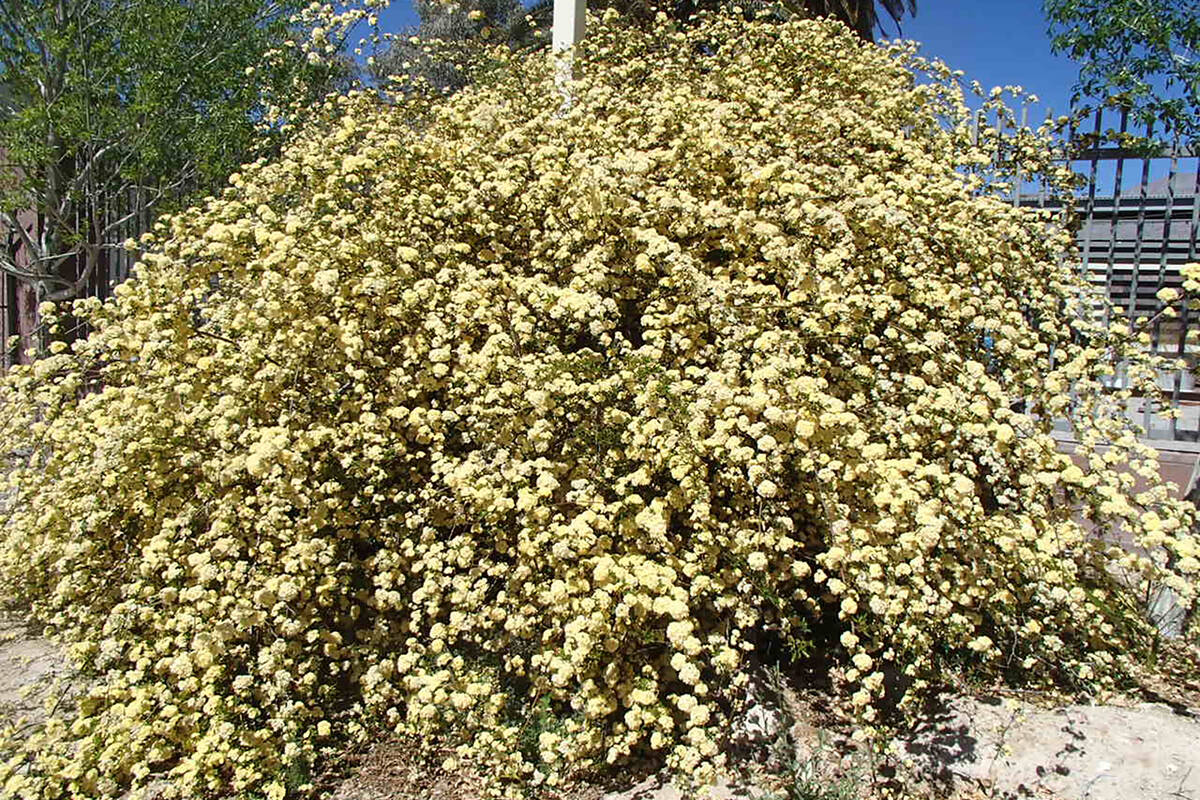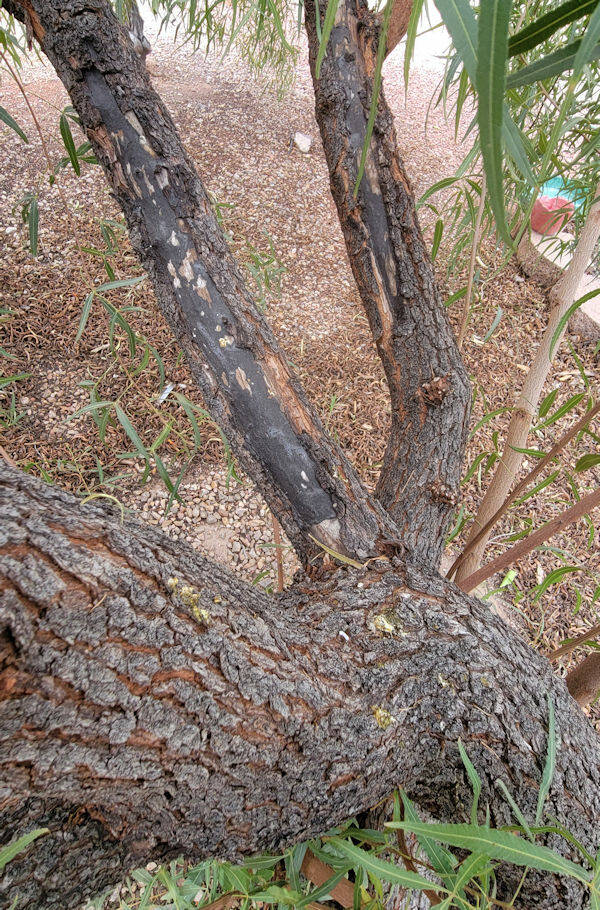What kind of mulch is best for newly planted vines?
Q: I recently planted two vines in my backyard: a Lady Banks rose and a tangerine crossvine. I got the amended soil at Viragrow and the wood chip mulch at the demonstration orchard as you suggested. Should I use wood chip mulch for both vines? How often should I add the amended soil or fertilizer to the vines after planting them?
A: When in doubt, use wood chips as a surface mulch. Mulch of all types (including rock) saves water and reduces weeding. Wood chip mulch, unlike rock mulch, rots into the soil and increases the organics of desert soil.
After planting, apply this mulch in a circle 6 feet wide from the trunk and 3 inches deep. When the wood chips get sparse, freshen this layer with new wood chips. Keep them away from the trunk until the plant gets woody (five or six years after planting). The idea is to have the wood chips decompose or rot during the first few months and add organics to the soil.
When using a fertilizer, the type is not important, but getting the nutrients it needs when it’s young, and applied to the right places, is.
After the hole is dug, apply a fertilizer high in phosphorus (something like a 16-20-0) at the bottom of the planting hole (a handful of fertilizer added to the soil at first when backfilling). A single application of fertilizer once a year in early spring is all the plant needs.
The Tangerine Beauty crossvine is a native, naturally climbing vine, found in the Southeastern U.S., from Florida to Maryland and west to Texas.
It is a vigorous vine with evergreen leaves and 2-inch reddish, trumpet-shaped flowers. It can cling to structures such as trellises, fences, arbors and brick or rock walls. It blooms in the spring with repeat blooms throughout the growing season. It’s an early nectar source for butterflies and hummingbirds.
Unlike the crossvine, the Lady Banks rose flowers only once, in the late spring, and is not a natural climber. Strong support must be provided. It grows to about 25 feet and is evergreen in warm climates.
Q: I bought straight compost. I told them I was going to use it for trees and shrubs planted outside. I hope this is the right product.
A: Make sure that whatever compost you use is mixed with sand at about one shovel full of compost to three shovels full of sand. Straight compost will be too “hot” and the wrong soil texture for plants that grow in soil. It will damage them.
The soil should be close to the same texture as the surrounding soil but be darker and hold water better. You never want to use straight compost in a planting hole because it contains a higher level of salt and is very different in its texture (water holding ability).
Q: We are planting a 30-gallon apricot tree. The hole is large and deep, but the bottom has lots of thin roots from nearby trees. I took out most of the bigger ones. Can I torch the small ones?
A: Roots no longer attached to the mother plant can be torched. Using fire to kill roots only kills the roots a few inches from the fire.
During the summer, clear plastic can be used to kill roots during the day. All roots and diseases are killed at 180 degrees in 30 minutes and allowed to solarize. That’s the temperature and length of time needed to sterilize dry soil 6 to 12 inches deep. If you are still not sure, then sever the roots from the tree with a sharp shovel.
By the way, it is less of a problem if the planting hole is dug wider but not deeper. When digging a planting hole, it is recommended to make it three times the width of the roots, but not any deeper than the roots or container. Unless there is a drainage problem (water added to the hole should drain overnight).
Q: What is the best way to get ants out of my potted plants outside?
A: The best chemical control method I have seen is a bait product made for several kinds of ants and manufactured by Amdro. I am sure other companies make similar products. Ants take this bait back to the nest, where it is fed to the queen as well as other ants. Control of ants is within 24 hours if done right.
The usual reasons for failure are because the bait was not placed near the nest or because it got wet. This product must be used dry so use it in containers when it is cool and immediately after irrigation. Follow to product directions precisely.
Q: I know you water a boxed tree to 24 inches deep, but do you water a new tree to 24 inches deep even if it is a sapling in a 15-gallon pot?
A: What we have done with newly planted fruit trees (planted among established fruit trees) is move drip emitters closer to the trunk during the first year.
These newly planted trees are irrigated 18 to 24 inches deep during this time, but the emitters are spaced on top of the rootball, close to the trunk. By fall, newly planted trees will become established and acclimated. The right number of drip emitters can be added for future growth at that time. The newly planted trees will become established when temperatures cool off (usually by the end of September or early October).
Planting during spring (late January through March) gives these plants time to get established by fall.
Once plants get established (provided the planting hole was dug wide enough), the water can be applied normally, with the other plants.
Q: About four years ago, my African sumac began showing dying leaves on a major branch. By the next spring, that branch had completely died and was cut off.
Upon inspection, several areas there and elsewhere on the tree, showed bark loss with an eruption of sap.
I initially coated the lost bark areas with a product from a local nursery. The tree has lost no further bark and seems to be growing rather uncontrollably with many, many vertical suckers. Is this tree worth saving? If so, how much pruning of new growth will it tolerate?
A: It looks like sunburn on the upper side of the main branches or limbs. If I am correct, this damage will heal on its own without help. Check the main branches to see if direct sunlight was damaging these limbs on the upper sides. The bottom of these limbs should be fine if the damage was due to sunlight.
If that was the case, the damage would have started when the limbs were young and not protected by older ridged and furrowed bark.
It looks like you will need some professional help when training this tree. Get a certified arborist the first year of pruning if you want to make this tree look good again.
Bob Morris is a horticulture expert and professor emeritus of UNLV. Visit his blog at xtremehorticulture.blogspot.com. Send questions to Extremehort@aol.com.























